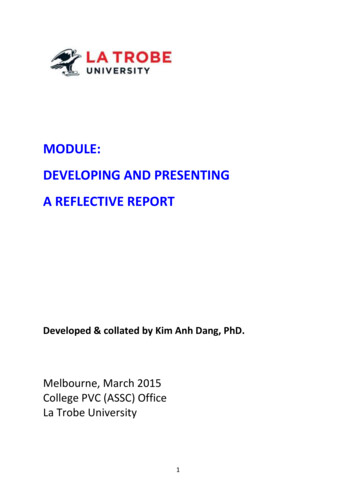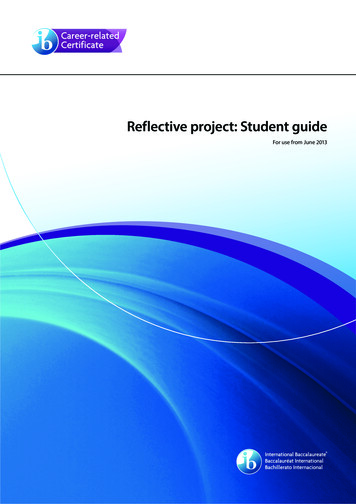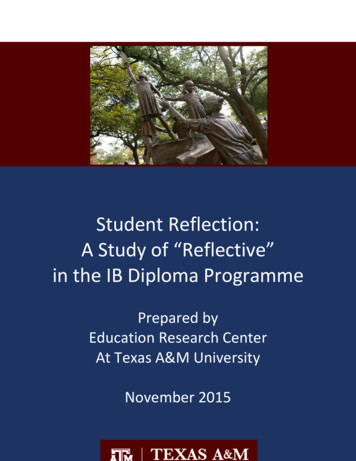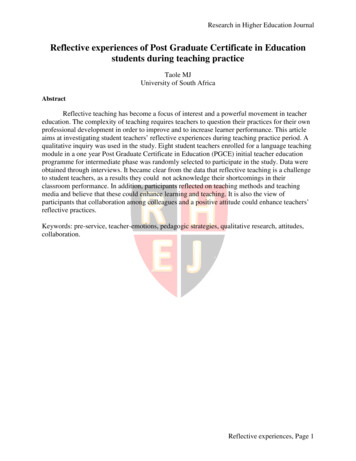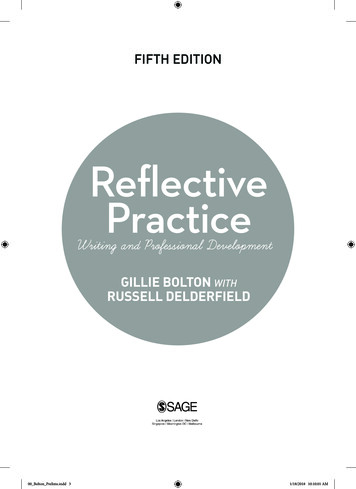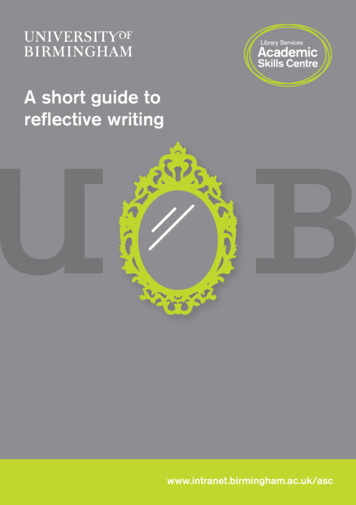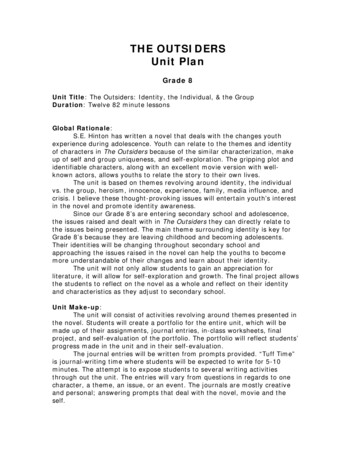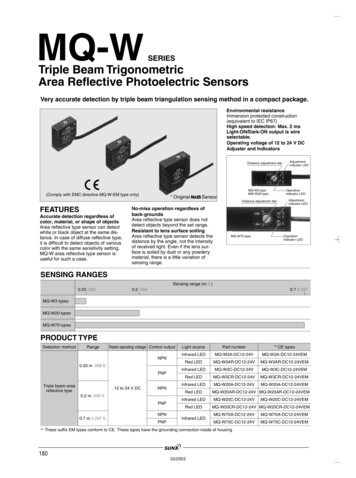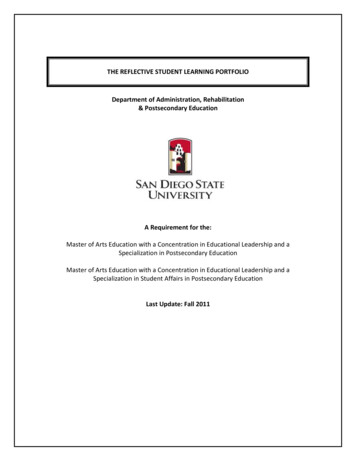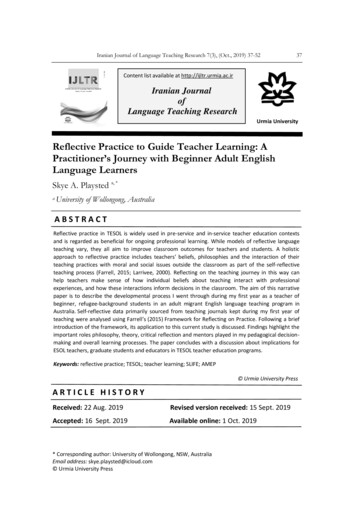
Transcription
Iranian Journal of Language Teaching Research 7(3), (Oct., 2019) 37-5237Content list available at http://ijltr.urmia.ac.irIranian JournalofLanguage Teaching ResearchUrmia UniversityReflective Practice to Guide Teacher Learning: APractitioner’s Journey with Beginner Adult EnglishLanguage LearnersSkye A. Playsted a, *a Universityof Wollongong, AustraliaABSTRACTReflective practice in TESOL is widely used in pre-service and in-service teacher education contextsand is regarded as beneficial for ongoing professional learning. While models of reflective languageteaching vary, they all aim to improve classroom outcomes for teachers and students. A holisticapproach to reflective practice includes teachers’ beliefs, philosophies and the interaction of theirteaching practices with moral and social issues outside the classroom as part of the self-reflectiveteaching process (Farrell, 2015; Larrivee, 2000). Reflecting on the teaching journey in this way canhelp teachers make sense of how individual beliefs about teaching interact with professionalexperiences, and how these interactions inform decisions in the classroom. The aim of this narrativepaper is to describe the developmental process I went through during my first year as a teacher ofbeginner, refugee-background students in an adult migrant English language teaching program inAustralia. Self-reflective data primarily sourced from teaching journals kept during my first year ofteaching were analysed using Farrell’s (2015) Framework for Reflecting on Practice. Following a briefintroduction of the framework, its application to this current study is discussed. Findings highlight theimportant roles philosophy, theory, critical reflection and mentors played in my pedagogical decisionmaking and overall learning processes. The paper concludes with a discussion about implications forESOL teachers, graduate students and educators in TESOL teacher education programs.Keywords: reflective practice; TESOL; teacher learning; SLIFE; AMEP Urmia University PressARTICLE HISTORYReceived: 22 Aug. 2019Revised version received: 15 Sept. 2019Accepted: 16 Sept. 2019Available online: 1 Oct. 2019* Corresponding author: University of Wollongong, NSW, AustraliaEmail address: skye.playsted@icloud.com Urmia University Press
38S. Playsted/Reflective practice to guide teacaher learning IntroductionInterpreting curriculum documents and making decisions about the most effective ways toimplement curricula in the classroom is part of an English as an Additional Language (EAL)teacher’s role. For teachers of beginner adult English language learners in Australian adult migrantEnglish Programs (AMEPs), this task is made more challenging by the fact that many of thestudents entering these programs are from refugee backgrounds, with interrupted schooling andtraumatic pre-migration experiences. Even teachers who have had a number of years of teachingexperience with EAL learners in other contexts can find that course materials and teachingstrategies which are useful with classes of formally educated, print-literate beginners are not soeffective when used with pre-literate, refugee-background beginner adults who have histories ofinterrupted schooling.In Australia, beginning teachers working with adult English language students who have hadlimited or interrupted formal education (SLIFE)1 are left in a gap between trying to apply adultliteracy teaching principles (appropriate for L1 English low-literate learners), early schoolingliteracy methods and materials (which are often not relevant or appropriate for adults) orbeginning adult coursebook materials and methods (aimed at learners who are formally educatedand print-literate). TESOL training courses rarely address this area of teaching in detail andfinding teaching resources or strategies which are culturally appropriate and sensitive to students’backgrounds of trauma is difficult for beginning teachers of adult SLIFE. Also, while guided bycurriculum documents and course materials, the decision-making process of how to teach coursecontent needs to reflect an individual teacher’s beliefs about learning and teaching. Becomingaware of how and what we are teaching, and how we make these decisions is therefore animportant step for beginning teachers. As they graduate from TESOL teacher educationprograms to teach EAL to adult SLIFE, beginning teachers are looking for ways to make sense ofthis complex decision-making journey.Self-reflection offers a way for beginning teachers to record insights into how their knowledgeand beliefs interact with the curriculum materials with which they are working. In the TESOLfield, a helpful framework for facilitating teacher reflection is Farrell’s (2015) Framework forReflecting on Practice. Explored in detail in the following sections, this framework offers teachers alens through which to view their reflective journey, and assists beginning teachers to become selfobservers and researchers of their own practice (Farrell, 2015). Reflective practice can help ateacher understand the complexity of their individual lived experiences, and how their knowledge“develops over time” (Freeman, 1996, p. 101). This study proposes the use of Farrell’s (2015)Framework for Reflecting on Practice as a means of assisting beginning EAL teachers of adult SLIFE tobetter understand and make decisions about their own teaching practice. Using my own beginningteaching journey as an example, I lend support to the view that systematic reflective practice is avaluable way for EAL teachers to make sense of their beginning teaching journey (Farrell, 2016)with adult beginner SLIFE. I encourage its use both in TESOL teacher preparation programs andfor beginning teachers of SLIFE, so that teachers of these students can become more aware ofhow their beliefs interact with teaching decisions and can develop confidence to understand andmeet the needs of adult beginner English language learners in their classes.AMEP teaching in Australia: Background and relevant literatureDeveloped countries such as Australia offer a home to around 15% (UNHCR, 2019) of refugeeswho have been forcibly displaced from their homes (85% of refugees continue to be settled indeveloping countries). While the figures of those resettled in Australia are not large whencompared with the global numbers of those displaced, Australia has significantly increased its
Iranian Journal of Language Teaching Research 7(3), (Oct., 2019) 37-5239intake of humanitarian entrants over the past decade (UNHCR, 2019). Newly arrived adults fromrefugee backgrounds are offered 510 hours of Commonwealth-funded English tuition to assistthem to more confidently “participate socially and economically in Australian society” (AGDET,2018, p. 1). Tuition to a level of “functional English” (AGDET, 2018, p. 1) is provided throughAMEPs in various adult educational training facilities across Australia. Recently, changes weremade to graduate TESOL teaching qualification requirements for AMEP teachers, and newcurricula and assessment frameworks were introduced into the program (Commonwealth, 2017).As a result of these changes, current teachers of AMEP requiring further graduate qualificationshave enrolled in university TESOL training courses, along with increasing numbers of graduatestudents hoping to gain future employment in AMEPs. There is therefore a growing need forgraduate TESOL teacher education courses to offer students explicit instruction in beginner adultEAL pedagogy.A review of literature also highlights a need for further research in the area of beginner adult EALpedagogy and instructional practices. AMEP teaching practices have been examined inOllerhead’s (2012b) research, which suggested that although teachers of adults with emergingliteracy in AMEPs had a vital role to play in understanding and meeting the learning needs of theirstudents, they may have been “engag[ing] in pedagogical practices that support[ed] a deficit modelof literacy” (Ollerhead, 2012b, p. 79). Dooley and Thangaperamul (2011) have claimed thatteachers of this cohort have tended to resort to teaching what they described as “basics [literacy]programmes” (p. 386), as they have sought to meet the challenge of teaching students with limitedEnglish language, low levels of literacy and interrupted schooling. AMEP teachers seekingbeginner adult EAL teaching strategies in current curriculum documents and assessmentframeworks have found that these guidelines focused more on a general integration of Englishlanguage skills across a range of learning areas than on EAL pedagogy (Button, 2019;Commonwealth, 2017).Burns’ (1996) study has explored how beginning AMEP teachers have developed their knowledgeabout teaching and found that teachers’ “underlying beliefs.shape the processes and interactionsthat occur [in their classrooms]” (Burns, 1996, p. 154). This research has also noted that theapplication of pedagogical principles to classroom practice is a complex process for teachers ofstudents from refugee backgrounds with interrupted schooling and low literacy (Burns, 1996).Colliander, Ahn and Andersson (2018) have claimed that teachers of adult learners from thebackgrounds described have “seldom [been] trained to teach learners who have little or noprevious education” (p. 306). This view has been supported by McCluskey (2011), who has statedthat “new teachers commonly begin their practice only to discover that they do not know how toteach adult [SLIFE English language learners]” (p. 59). Other literature has also highlighted alack in formal teacher training to prepare teachers to work with adult SLIFE (Bigelow &Vinogradov, 2011; DeCapua, Marshall & Frydland, 2018).Research has been ongoing into issues surrounding English language teaching approaches at ahigh school level in Australia (Creagh, 2014; Dooley & Thangaperumal, 2011; Windle & Miller,2012). English language learning and teaching is an issue which has also been addressed inresearch on enabling programs and pathways for refugee background students entering tertiarystudy, a number of whom have moved through AMEPs into these tertiary programs (Naidoo,Wilkinson, Adoniou & Langat, 2018; Ramsay & Baker, 2019). A recent study by Dallimore (2018)into improved outcomes for refugee background Afghan students in AMEP has focused onstrategies which AMEP providers have used to improve student participation and attendance.Yazdanpah’s (2015) quantitative study of teacher knowledge, which included teachers of AMEP,has provided insights into teacher knowledge and values in Australian adult ESL settings. Finally,extensive research has been conducted into the former AMEP curriculum, the Certificate ofSpoken and Written English (CSWE) (Burns & De Silva Joyce, 2007; Bryant, 1995; Macquarie,
40S. Playsted/Reflective practice to guide teacaher learning 2016; Moore, 1996), but funding contracts for this research during the 1990’s through to 2009have since ended, and new AMEP curricula are now in place (Burns & De Silva Joyce, 2007;Commonwealth, 2017; Macquarie, 2016).In light of the above review, a need exists for further research to explore issues of beginner adultEAL pedagogy and “how teachers approach their work with [beginner adult English language]learners” (Colliander, Ahn & Andersson, 2018, p. 308). To contribute to this area of need, thecurrent study uses Farrell’s (2015) Framework for Reflecting on Practice to describe the developmentprocess I went through during my beginning year as a teacher of adult SLIFE English languagelearners in an AMEP. By reflecting on the interaction of beliefs and knowledge with decisionsmade in teaching practice, my experiences demonstrate that reflective practice is an effective toolfor raising awareness of issues faced by beginning teachers of these learners and can guideteachers on their professional learning journey. The question which guided my reflection processwas:What processes do beginning teachers go through in making decisions aboutpedagogical approaches and teaching priorities when teaching beginner adult SLIFEEnglish language learners?Personal background and teaching contextThe present study is situated in the context of my initial 16-month teaching and learning journeyin TESOL. I had enrolled as a graduate student in a university TESOL education course after 22years of teaching in schools. My undergraduate degree had been in music and German as a secondlanguage, so I was familiar with language learning and teaching. While I studied TESOL, I gainedsome initial English teaching experience by volunteering at a local refugee support centre, where Itaught a group of 10 beginner-level, female English language learners from Afghanistan, SouthSudan, the Congo and Syria. The women in this group were mothers aged between 30-50, withlow levels of literacy (in their L1s and in English) and limited experiences of formal education.Most of the women had lived in Australia for at least a year, some for up to seven years and theyattended the centre’s English classes weekly. The classes provided a strong social network for thewomen as well as an opportunity to develop their English language skills. There were no setcurriculum materials for these lessons, but topics were suggested as a guideline for teachers tofollow (e.g., food, shopping, personal information). I found it challenging to meet the languagelearning needs of students at different levels in the same class, and it was difficult to find teachingmaterials appropriate for beginner adult learners. However, it was during this time that Ideveloped a deep respect for the refugee-background students I was teaching and realised that Ihad as much, if not more to learn from my students as they did from me (Playsted, 2019a).On completion of a postgraduate TESOL qualification, I began to work as a casual teacher in anAMEP. I taught a variety of classes, but mostly worked with a group of 19 young adults agedbetween 16-24 who had recently arrived in Australia from Syria, Iraq and Iran. The studentsspoke Kurdish (Kurmanji) and Arabic, and one student spoke Farsi as an L1. The 10 women and9 men in the group were beginner English learners, with varied experiences of formal educationin their home countries. Although some students had been to primary school for 2-5 years andothers had attended school into their middle high school years, all the students had experiencedinterrupted schooling due to war and forced displacement from their home countries. Those whohad attended school were literate in Arabic and had participated in English classes while they werein high school in Syria, Iraq or Iran. However, due to the students’ ages and low levels of Englishproficiency, they were offered intensive English language tuition in an AMEP rather than amainstream high school in Australia. Students expressed a desire to either study at a university,
Iranian Journal of Language Teaching Research 7(3), (Oct., 2019) 37-5241complete a vocational training course or gain employment after they finished their AMEP studies.During the first part of my initial year as an AMEP teacher, the curriculum in place was theCSWE (Bryant, 1995). Pedagogical approaches and teaching materials available in the CSWE(Bryant, 1995) were based in Halliday’s (1985) theory of language learning, in which language wasviewed according to its function “in [a] context, as opposed to isolated words or sentences”(Halliday, 1985, p. 9). Although I had been introduced to Halliday’s (1985) concepts briefly duringmy university studies, I found it challenging to understand how I could apply them effectively inthe beginner adult EAL classroom. Further to this, as mentioned earlier, changes to AMEPcurricula were taking place throughout the year. The new curriculum, the Australian Core SkillsFramework (ACSF) for assessment (Commonwealth, 2017) and the CSWE curriculum (Bryant,1995) shared some similar topics for introduction at beginner levels, but teaching materials,assessment tasks and administrational processes aligned with the new curricula were unfamiliar tome.In addition to familiarising myself with new curricula during my first year of AMEP teaching, Iwas becoming familiar with a new teaching environment. In spite of my TESOL training andyears of experience as a second language teacher, I felt quite ‘out of my depth’ in this newclassroom context. I was not prepared for the complexity of teaching beginner adult refugeebackground English language learners. Although I was keen to apply pedagogical research frommy TESOL studies in the classroom, I found it challenging to adapt or apply many of the theoriesand strategies to the setting in which I was teaching. In order to better understand the complexityof this teaching context, I became more reflective in my practice (Farrell, 2015; Mann & Walsh,2017). I journaled my experiences in the classroom, notes from conference presentations anddiscussions with teaching colleagues and mentors about pedagogy. Two of these mentors inparticular played important roles in my personal and professional development. The first mentor,John2 was a university lecturer with whom I corresponded regularly as part of my distanceTESOL education coursework. Hannah, the second mentor was an academic with extensiveexperience in beginner EAL teaching and knowledge of the AMEP’s historical development.Hannah generously shared this knowledge with me via email communication throughout myinitial year of AMEP teaching. It was during this time that I also became aware of my beliefsabout language teaching (Farrell, 2013), and how these beliefs shaped my teaching practice andchoices about what and how I taught (Farrell, 2013; Yazdanpah, 2015).Methodology and Farrell’s Framework for Reflecting on PracticeThe approach chosen to explore this study’s research question was a qualitative and interpretiveapproach, which “rel[ies] as much as possible on the participants’ views of the situation beingstudied” (Creswell, 2014, p. 69). I was the primary participant in the research, and “[my]interpretation flows from [my] personal experiences” (Creswell, 2014, p. 5). As a narrative study,I have drawn on my “lived experience” (Clandinin, 2006, p. 44), recorded in self-reflectiveteaching journals (Playsted, 2018a) and a conference paper which was prepared for the AppliedLinguistics Association of Australia (ALAA) conference (Playsted, 2018b). Additional emailcommunication (see Appendix A) and personal blog posts (Playsted, 2019a; Playsted, 2019b;Playsted, 2019c) were referred to during the analysis of the primary data, as these recorded someof the “critical incidents” (Farrell, 2015, p. 116) which influenced my decision-making processduring the period of reflective journaling.
42S. Playsted/Reflective practice to guide teacaher learning Figure 1. Farrell’s Framework for Reflecting on Practice (Farrell, 2015, p. 23)Farrell’s (2015) Framework for Reflecting on Practice (see Figure 1) was used as a lens through which toview and reflect on different stages of my development as a beginning teacher in an AMEP. Theflexible nature of this framework “allows teachers to decide where they want to begin theirreflections” (Farrell, 2015, p. 23), and identifies five stages of reflection: philosophy, principles, theory,practice and beyond practice (Farrell, 2015, p. 22). Reflection on teaching practice can be used as atool for professional development or to gain insights into particular teaching contexts (Mann &Walsh, 2017). In my case, reflection on my first year as a teacher of beginner adult SLIFE in anAMEP also helped me negotiate my way into and through a challenging new teachingenvironment (Farrell, 2016). Reflective journaling became a way for me to come to terms with thechallenges and changes referred to in the previous section of this paper.Journal data were recorded and analysed chronologically, using the research question to guideanalysis. During this analysis, “critical incidents” (Farrell, 2015, p. 67) such as impacting events orpersonal interactions were identified, as these highlighted different stages of the reflectiveframework (Farrell, 2015). The incidents are documented in Appendix A. Designing a table (seeTable 1) to categorise timeframes and the five phases of Farrell’s (2015) Framework for Reflecting onPractice allowed me to visually track my developmental journey as a beginning teacher of adultSLIFE English language learners. It also revealed to me the interconnected and cyclical nature ofeach of the stages of the framework (Farrell, 2015, p. 22) in my process of reflection. The tableand a figure exemplifying this cycle are discussed in the following section of this study.
Iranian Journal of Language Teaching Research 7(3), (Oct., 2019) 37-5243Table 1Application of Farrell’s Framework for Reflecting on Practice to Personal Teaching JourneyTimeframeJanuary 2018March 2018Stage ofReflectionPhilosophyBeyond PracticeJune 2018TheoryJuly – August 2018September-December2018TheoryPracticeOctober 2018PhilosophyMarch-April 2019PrinciplesBeyond PracticeMarch-May 2019PhilosophyCritical IncidentContemplating how and why I teachCritical reflectionInfluenced by Fasching-Varner and RodriguezCritical pedagogyCulturally relevant teaching (CRT)Communication with DeCapuaInfluenced by DeCapua and Marshall’s work with SLIFESociocultural theory (SCT) and dialogic teachingSydney TESOL ColloquiumInfluenced by Chen’s presentationTeaching beginners with a dialogic approachChanges in AMEP curriculaContemplating my contribution to the teachingcommunityACTA conferenceBreak from AMEP teachingReflecting on my assumptions about dialogic teaching asa ‘method’Understanding SCT as part of CRTEmail communication with Hannah and JohnEmail communication with DeCapuaPreparing paper on intercultural communicationContemplating how and why I teachEmail communication with John and HannahReflecting on reflective practiceFindings and discussionImportance of reflecting on philosophy, theory and beyond practiceThree stages of reflection, philosophy, theory and critical reflection (beyond practice) (Farrell, 2015)significantly guided my pedagogical decision-making process. My beliefs about these aspectsevolved, and I returned to these three stages of reflection in different ways throughout my firstyear teaching journey (see Table 1). My initial experiences of feeling inexperienced and illequipped (see Appendix A) to deal with the complexity of teaching the adult SLIFE learners inmy class prompted me to begin reflection in the phases of philosophy, beyond practice and theorythroughout my first year of working with these students (see Table 1). The statement: “If myexpectations [of students from refugee backgrounds] are different, my talk in the classroom will bedifferent” (Playsted, 2019b) reveals the influence of critical reflection (Farrell, 2015) on mythoughts about my actions in the classroom. During this period, a growing awareness of culturallyrelevant teaching (Playsted, 2019c) and the theme of “the nature of the talk that occur[s]in classrooms” (Gibbons, 2006, p. 8) also emerged, influencing my decision to explore dialogicteaching theory (Alexander, 2008). The phases of reflecting on philosophy and theory bothmotivated my initial decision to work with adult SLIFE learners and were also phases I returnedto throughout my first-year teaching journey (see Table 1).It is important for beginning teachers to engage in critical reflection (beyond practice) from early intheir teaching journeys. Teaching requires “considerably more than accumulating skills andstrategies” (Larrivee, 2000, p. 293) and an individual teacher’s beliefs form the basis of decisions
44S. Playsted/Reflective practice to guide teacaher learning made in the classroom (Yost, Sentner & Forlenza-Bailey, 2000). The process of“assessing beliefs, assumptions, and ways of thinking and doing” (DeCapua, Marshall &Frydland, 2018, p. 32) is essential for teachers whose students from refugee backgrounds areoften viewed “as victims or as culturally deprived” (Rodriguez, 2015, p. 113).Returning to stages of reflectionThe learning process I went through as a beginning teacher was not a chronological, linearprocess (Burri, 2016; Farrell, 2015), but one of “looping back and forth (or framing and reframinga problem)” (Farrell, 2015, p. 4). This was evident in my return to the phases of contemplatingphilosophy and theory (see Figure 2), as I moved through phases of reflecting on my practice and theprinciples that guided my teaching decisions in the classroom. While I applied a reasonablysystematic and chronological approach to journaling my reflections as a beginning teacher (seeAppendix A), reasons for changes in cognitions and decisions did not appear to relate to aparticular chronological order (see Table 1). The aspect of time which did appear to be asignificant factor affecting my reflections and decisions about theory and philosophy (see Table1), was that of time away from teaching in a particular environment (see Table 1).Figure 2. Personal reflective journey mapped to Farrell’s Framework for Reflecting on PracticeTime “on the job” (Gatbonton, 2008, p. 178) does not necessarily translate into increasedteaching expertise. A teacher’s learning is marked as much by an understanding of the “processesof cognitive change” (Borg, 2009, p. 168) which they go through, as it is by years of experience.Some time alone for reflection is important for beginning teachers, as it allows them to “gain, orregain, a sense of meaning and purpose in their teaching” (Larrivee, 2000, p. 297). In my case,though changes in my cognitions and decisions about teaching theories did not appear to relate tothe passing of time, taking time out to journal experiences helped me to examine the “criticalincidents” (Farrell, 2015, p. 47) which were shaping my beliefs and practices (Borg, 2009).
Iranian Journal of Language Teaching Research 7(3), (Oct., 2019) 37-5245Reflection as ongoing practiceAt the time of journaling and preparing a conference paper in 2018 (Playsted, 2018), I had onlybriefly read Farrell’s (2015) work on reflective practice. I was not using reflective journaling to“look at or for ‘best practices’” (Farrell & Bennis, 2013, p. 175) at the time, but simply as a way ofrecording and making sense of my own journey. The exercise of reflecting on my teaching practicethrough Farrell’s (2015) Framework has since become one which I see as valuable for ongoingprofessional learning. Two recent statements exemplify my growing awareness of this, and of anappreciation for this Framework (Farrell, 2015) as a lens through which I can understand myjourney as a practitioner:“ now that I’ve looked at my teaching journey through that framework. It was really interesting!”(Personal communication with John, April 2, 2019)“My reflections are more ongoing than just related to my studies” (Journal entry, April 15, 2019).While teacher learning may have traditionally been concerned with “improving the effectivenessof delivery” (Richards, 2008, p. 164), reflective practice through a holistic framework (such asFarrell’s Framework) takes the process of reflection past practical classroom teaching problems tobe ‘solved’. Ongoing reflection gives beginning teachers confidence to understand and have inputinto their own learning journey. For teachers who work in regional areas as I do, opportunities forcontinuing professional development are few and far between. In these situations, reflecting onpedagogical theories “can be a substitute for absent colleagues” (Farrell, 2015, p. 67).Mentors are more than ‘experts to copy’Mentors are essential in “provid[ing] insights to help [beginning teachers] in their journey”(DeCapua, Marshall & Frydland, 2018, p. 21). Interactions with mentors guided my decisionmaking process about teaching approaches and priorities, and changes in my cognitions aboutteaching (see Appendix A). Pedagogical decisions I made in the classroom during 2018 (seeTable 1) were heavily influenced by Chen’s (2018) presentation about teaching argumentation tokindergarten-aged children. I saw similarities between the learners she was describing and theadult SLIFE English language learners I was working with (Playsted, 2018b). This influenceddecisions about practice and prompted me to reflect on practice in a systematic way (seeAppendix A).Mentoring was also evident in my email communication with John and Hannah (see AppendixA) as I discussed historical developments and changes in the AMEP. Change then became atheme which I embraced as enhancing my development as a teacher. This is evident in a recentdialogue with John:Skye: “It’s interesting how we talk – me about beginning now and [Hannah] about the history. Made merealise no decisions are neutral or made in a void”John: “It’s great to see your thinking evolve” (Personal communication with John, March 26, 2019).DeCapua’s work and communication (see Appendix A and Table 1) has also had a mentoringinfluence on my decision-making process. After reading and emailing her about her work withSLIFE in June, 2018 (see Table 1), my thinking moved through an initial phase of philosophicalcontemplation about culturally relevant teaching, through a phase where I applied theories to
46S. Playsted/Reflective practice to guide teacaher learning practice and returned to a point where I began to see my teaching decisions as part of, rather thanapart from, culturally relevant teaching theory.Johnson and Golombek (2003) describe teacher learning as a “transformative process” (p. 735), inwhich “novices do not merely copy experts’ capabilities; rather they transform what the expertsoffer them as they appropriate it” (Lantolf, 2000, p. 17). This process takes time and an ongoingwillingness to communicate on the part of mentors. For any beginning teachers, and particularlythose of adult SLIFE who have had little explicit training or support to work with this cohort ofle
teaching practices with moral and social issues outside the classroom as part of the self-reflective teaching process (Farrell, 2015; Larrivee, 2000). Reflecting on the teaching journey in
